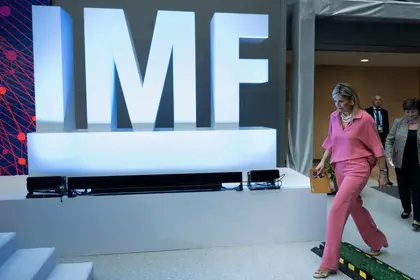Over the past week the IMF announced a major package of support for Ukraine, with the unveiling of a $15.6bn 48-month Extended Financing Facility (EFF). This was part of a broader package of support for Ukraine agreed by international donors totalling around $115bn for the period through to 2027.
The Fund should be commended for providing such a large anchor programme for Ukraine in truly exceptional circumstances. Indeed, the IMF almost never lends into on-going war/conflict scenarios, primarily as such situations are incredibly difficult to predict and it’s almost impossible to produce credible macro frameworks which give Fund shareholders confidence in the first question for any Fund programme - will the IMF get paid back?
The Fund produced a macro framework this time around but I think most people would accept that - while it might be internally consistent and the numbers might add up - it is kind of a work of fantasy. And absolutely no criticism of IMF staff here as its just impossible to make any credible macro assumptions at this time with the war on-going. Indeed, while the Fund talks about +3/-1% real GDP growth assumptions for 2023, I would more likely have +/-10% on any numbers I would give. Hey, and I am saying that as a guy who has been covering Ukraine’s macro since independence in 91’, actually before then back to 88’.

‘Just Peace’ and ‘Lasting Peace’ – Nations React to Trump’s Inauguration
But important context herein is that key Western IMF shareholders see the absolute strategic necessity for Ukraine to be financed through this war and the early part of reconstruction assuming a base case of the war petering out in the first half of 2024. So with that context the IMF team were tasked with coming up with numbers which seemed coherent under a certain set of assumptions. They have. The macro forecasts are fingers in the air but that’s fine as those same key Western shareholders have provided the IMF with sufficient financing assurances that they will continue to write cheques for Ukraine to enable it to win this war almost whatever the macro outturn ends up as being. They just needed some, any, macro assumptions. And here we have them.
This programme does the trick though in terms of what it’s core objective is
- it signals to Ukraine - and as importantly to Russia - that the IMF and its key Western shareholders stand behind Ukraine for the long haul. And this programme will also act as a framework for other official and bilateral to provide financial support for Ukraine.
The numbers in a way are meaningless - whatever the financing gap to win the war, and hopefully then peace, will be found. The victory of Ukraine in this war and its success in the subsequent peace is mission critical now for the West. This IMF programme spells that out. And I guess for donors the fact that the Ukrainian government has signed up to the document signals a commitment to maintain and accelerate reforms from the period before the invasion.
I guess the fact that the EFF extends beyond the US election also provides some assurance for the nightmare scenario for Ukraine of a Trump win in 2024 - albeit let’s all hope the war is won before Trump would assume office in 2025.
A few additional thoughts:
First, the programme has a base case and then a bearish macro case anticipating bigger real GDP declines of 10% or so for 2023. It does not spend much time on a better or best case scenario which, in my mind, is as likely as the bearish case. In fact while assuming a much steeper real GDP fall in the bearish case it only assumes a 1% additional growth impulse to the base in a better case scenario. I would argue that an early end to the war in late 23’ or early 24’ will more likely see a big real GDP growth rebound - after a 30% real GDP loss this year. Alongside the huge low base effect I would reflect on the huge real and dollar GDP growth recovery from 2014-15, after dollar GDP collapsed from $180bn to $90bn it was quick to bounce back thru the then $125bn GDP warrant triggers and back up to $180bn just before the invasion in 2022. Add in here a huge reconstruction spend, the positive drivers from the now serious EU accession process and simply the innovation miracle that we have seen from Ukraine in how it has conducted this war. Ukraine could well see a spurt in investment and innovation at the end of the war. In fact I am a Ukraine growth/recovery bull post war. So for me the IMF is too conservative in its assumptions - and I get why - notwithstanding uncertainties around the timing of the end of the war - it’s paid to be cautious. It’s shareholders want to be paid back. But if the war ends early - and by 2024 - I am convinced growth will surprise to the upside. This war has created a different Ukraine which, once the war ends, will have a much better outlook than at any time over the past thirty of years of independence.
Second, the IMF notes Paris Club creditors’ decision to extend the debt service suspension, agreed last August, for three years beyond the end of 2023 as agreed already, raising then the prospect of a two stage debt treatment. So I guess this suggests a first stage three year extension and then a further treatment towards the end of the programme in 26/27 mindful then of DSA maths at that point of time. It then talks about starting negotiations with private creditors around the end of 23/24 which I assume will be to ask for a comparable three year extension of the debt service pause to that agreed with the Paris Club. In the context here of massive uncertainties on the development of the war and macro assumptions it’s hard to see private creditors agreeing in 2024 to anything more than a further extension to the debt service pause. They will likely argue that they agreed to a two year debt service pause in August 2022 to help Ukraine win this war and would suggest regrouping at the end of the war to then look at the numbers again when credible assumptions can be made around the DSA. The message will likely be we want to help but let’s figure out solutions when we actually can make credible and sensible forecasts as to the macro outlook. Until that time we are happy to wait.
Related really is the IMF assumption, contained in the EFF document, that with no debt treatment the public sector debt to GDP ratio, which rose from less than 50% at the onset of the war to 82% as of the end of 2022, will then likely peak at 105% by the end of 2024, and then decline to 77.8% by 2033. That does not appear as a particularly high level to target, when one thinks that for a similar Market Access Country (MAC) - Sri Lanka - the IMF seems content to target a 95% debt to GDP ratio, arguing that that is sustainable. Not sure why the IMF thinks 95% debt to GDP is sustainable in Sri Lanka and not Ukraine. And remember also that after the 2015 debt restructuring, Ukraine’s debt to GDP ratio was still 79%, a level deemed sustainable by the IMF at that time, and again after a pretty precipitous real and Dollar GDP decline. It was then able to massively cut that ratio with growth recovery, real FX appreciation and prudent fiscal policies which all seem likely in a post war scenario.
Again I guess the numbers don’t really mean that much, the reality is Ukraine will need as much support from Western creditors as possible, to enable it to win the war and then secure the peace. Let’s look at the data at the point the war ends. It’s kind of meaningless to do very much in terms of a more thorough debt treatment until then.
Ukraine will though need market access very soon after the war ends to ensure the private sector steps up to support the reconstruction efforts, so some thought needs to go into how talks with creditors are going to pan out - a continued extension of the debt service suspension will just limit new money private sector capital market financing of Ukraine.
Third, I did not find any mention in the document of the use of frozen Russian assets for financing Ukraine through the conflict or the reconstruction. In a way by not saying anything the fund is normalising the view that these assets cannot be touched because (I would argue) of false and unjustified perceptions that the protection of property rights in their case trumps everything else. It kind of suggests that Western tax payers are fine in financing the war and Ukraine’s reconstruction even though Russian assets are available and in Western jurisdictions. I don’t think this stacks up. Why should Western tax payers (or in fact Western creditors) pay for Russian actions in Ukraine when there are upwards if $400bn in Russian assets in Western jurisdictions which can and should be diverted to the use of Ukraine. It makes no sense.
I have argued separately why frozen Russian assets absolutely should be used for Ukraine’s reconstruction. The West just needs to think more creatively, and officials in Western treasuries need to wake up to the fact that Putin is at war with Ukraine but also us, the collective West. Putin wants to cause division and political instability in Western liberal market democracies, and the chances of that are higher if tax payers in those same Western liberal market democracies are made to stump up the bill for Putin’s war in Ukraine. Wake up folks, we are at war!
The IMF report should clearly state that assumptions on Western financing and future debt treatment is dependent on resolution of issues around the use of frozen Russian assets - this needs to be spelled out.
I have argued that if there are nerves around what the allocation of these frozen Russian assets to Ukraine means for the protection of private property rights in the West, then one can think of solutions where these assets are used to purchase Ukrainian bonds issued for reconstruction. The assets bought can technically remain in the ownership of Russia, while Ukraine gets to use the proceeds from such bond sales for financing its defence and reconstruction. The West needs to think outside the box, and it might have been interesting to see the IMF come up with some innovative solutions therein.
Linking back to any future private creditor treatment, perhaps solutions can be thought of where thru any future debt treatment, creditors secure a claim on frozen Russian assets. This might encourage more favourable treatment from creditors. New bonds can also perhaps be issued secured against frozen Russian assets.
Reprinted from CEPA’s Europe Edge and @tashecon blog [email protected]. See the original here.
The views expressed in this opinion article are the author’s and not necessarily those of Kyiv Post.
You can also highlight the text and press Ctrl + Enter










